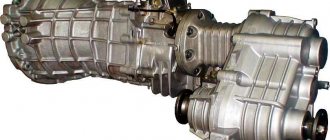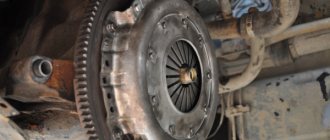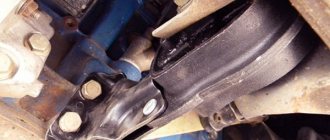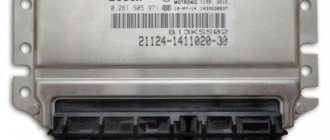Why does a manual transmission howl?
Many manual transmissions, even in good condition, are not very quiet. Even on a new car, the transmission can make sounds while driving, this is especially true for vehicles in the budget segment. For example, the whine of a VAZ gearbox is the norm for many cars. Every owner knows what the normal noise level is inside his car, and will always notice changes. If the noise of the box changes in tone, competes in volume with the sound of the engine, or appears in some specific conditions, you need to think about a visit to a car service center.
Many people confuse noise in the box with malfunctions of other elements. Often, while driving, a worn-out release bearing howls. The volume and tone of the noise directly depends on the speed of movement, so the diagnosis of “box whine” is mistakenly made. A clutch that requires replacement can also cause a similar problem. Without diagnostics, it is difficult to figure out what causes the unpleasant sound, so it is better to contact a car repair shop.
If the manual transmission itself makes a hum, there may be several reasons:
- If there is insufficient lubrication, a hum may occur due to intense friction of parts. The howl is heard especially clearly in higher gears.
- Noise may occur after improper repair of the gearbox. Assembly requires precision. If the shafts and gears are misaligned relative to each other, the box will make noise.
- A common cause of noise is failure of synchronizers. This malfunction is usually accompanied by a grinding noise when engaging certain gears.
- If the noise is present when the gear selector is in neutral, there is likely a problem with the input shaft bearing.
- The pinion bearing may also make a noise.
- Wear of the main pair is another source of box howling. If measures are not taken in time, other parts will also fail.
- If the whine is only heard in a certain gear, the cause lies in the gears. If their teeth are damaged, the box will hum.
- If the box hums when cold, especially in the winter, the culprit may be that the oil is too thick. After warming up, the transmission is much quieter.
- Old oil in a box may contain metal shavings and other impurities. This may be the cause of the noise.
If a howl appears in the box, pay attention when it occurs, whether its pitch and volume changes in different modes. If noise appears when the clutch is depressed, there is a crunching sound when engaging 1st or 2nd gears, there is a high probability of wear of the release bearing. Extraneous sounds when engaging certain gears indicate problems with gears or synchronizers. A humming noise in higher gears or in cold gears may indicate an insufficient level or low quality of transmission oil.
How to eliminate noise and hum in a gearbox: an alternative to transmission additives
January 25th, 2015 Victor
The “howl” of the gearbox bothers car owners just like any other extraneous sound in the car. The functioning of a serviceable gearbox - mixing of oil, engagement of teeth, operation of bearings - should not be heard while driving. Therefore, the “singing” of the transmission is one of the first reasons to visit the diagnostics.
As a rule, this very “singing” is caused by banal reasons:
- Increasing gaps between individual parts.
- Teeth wear.
- Incorrect oil viscosity.
gearbox additives without any hesitation.
. They pour it in... And they wait for a miracle effect, which you won’t find during the day, even if you look very hard.
The problem is that such drugs are poorly studied. Many of them form a protective film for a limited period of action, so it is not possible to evaluate any long-term positive effect.
The main danger posed by transmission additives
, – corrosive and abrasive wear. This primarily concerns layered, metal-clad additives, and metal conditioners. This feature negates all the advantages of the above-mentioned drugs. Therefore, car owners are looking for a worthy alternative, which is friction geomodifiers. Their main advantages:
1) Possibility of in-place repairs.
2) Formation of a protective layer on the surfaces of mechanisms that is absolutely safe for transmission.
3) Reduced wear rate.
4) Improvement of friction indicators.
The disadvantages of friction geomodifiers include the need to strictly follow the instructions, which is somewhat higher than the cost in the case of additives. Sellers of such products claim 100% effectiveness of the compositions, although they honestly admit: if the wear is more than 60–70%, nothing will help except a complete overhaul with disassembly.
Let's look at what friction geomodifiers are using the example of RVS-Master Tr3, Tr5. Let's figure out why anti-drone additives in gearboxes are significantly inferior to these compounds.
The Finnish-made product received a certificate of compliance with Russian state standards
. The composition is based on magnesium silicates. RBC particles do not change the chemical composition of the oil.
Under the influence of temperature, a new crystal lattice is built on the friction surface: an exchange of Mg and Fe atoms occurs, and a protective metal-ceramic coating is formed. This way the nominal dimensions of the parts are restored. The standard friction system creates an optimal secondary structure that is ideal for the given operating conditions.
The howl of an automatic transmission, robot or variator
Automatic transmissions are normally quieter than manual transmissions. If the howl of a manual Niva or Lada Kalina transmission may be a normal condition of the transmission, then third-party sounds from the automatic transmission should alert the car owner. Diagnosing the causes of third-party sounds when operating automatic transmissions is quite difficult. Sometimes computer diagnostics can help identify the problem, but in most cases you have to remove and disassemble the transmission. Having learned the cost of this procedure, many continue to drive a car and drown out the howling with loud music. But this is wrong; with significant wear of all internal components, repairs will cost more than with minor problems. In addition, a faulty transmission can fail at any time.
The main reasons for howling automatic transmission:
- If there is little transmission fluid in the box, usually not only extraneous sounds appear, but also kicks when changing gears.
- If the automatic transmission starts to howl after repair, it may have been assembled incorrectly. Even a slight displacement of parts leads to the appearance of third-party sounds.
- If the axle shafts are poorly secured, play occurs, which leads to noise.
- The quality of the transmission fluid also affects the operation of the automatic transmission. If the oil is old, contains mechanical impurities, or a fluid that does not meet the manufacturer’s requirements is filled in, the box will begin to hum.
- Worn or damaged gears, bearings and other mechanical parts lead to the appearance of extraneous sounds.
An automatic transmission is a rather complex mechanism compared to a manual transmission, which is why it is more difficult to identify the cause of the howling. But even if you need to disassemble the transmission with troubleshooting, it is better to perform this procedure than to face a critical breakdown along the way.
The “Check Engine” light came on on the dashboard.
If the “Check Engine” indicator suddenly lights up on the dashboard of your car, this may be the first sign of not only a malfunction in the engine, but may also tell you about incipient problems with the transmission.
Your car is usually equipped with various electronic sensors that interact with the engine control unit. Several sensors are also found in the gearbox of many modern cars. And if your transmission has problems, then the car’s computer can receive a signal from the sensor. In this case, an engine icon may appear on the dashboard.
By the way, sensors in the transmission can detect problems with the transmission, even with a subtle jerk or slip. Also, the sensors can detect faster than you the slightest vibration in the operation of the transmission, which you may simply not notice.
Therefore, you should know that the Check Engine icon on the dashboard never appears just like that. In this case, your car needs comprehensive computer diagnostics, which will determine the cause of the engine light.
What to do if the box howls
The first thing a car owner should think about when a howling noise appears in the transmission is a transmission fluid leak. Inspect the car's riser for oil stains, assess the oil level in the box using the dipstick, which most car models have. If the transmission fluid level is below the minimum mark, it must be topped up immediately. Use only the brand of oil that comes in the box. You cannot mix liquids from different manufacturers. You should know that automatic transmissions are very sensitive to the level of lubrication, so an overflow of transmission fluid is as unacceptable as a lack of it. If the oil has not been changed for a long time, it should be done. Automatic transmissions are especially sensitive to the quality of transmission fluid.
If it was not possible to eliminate the howling of the box by replacing or adding oil, you need to go to a service station for diagnostics. Specialists will assess the condition of the transmission and tell you how much repair is needed.
If you decide to sort through the box, you should take into account that the cost of such work is quite high. That is why it is advisable to purchase new original spare parts. Only in this case can you count on a long service life of the transmission after repair. Buying used spare parts or cheap parts from a dubious manufacturer is an imaginary savings. There is a high probability that soon after such repairs the gearbox will have to be disassembled again.
If the main pair is damaged, it is rarely possible to get by only by replacing it. Usually in such a situation other parts also suffer, so you need to evaluate their condition and, if necessary, also replace them.
Sometimes repairing a box turns out to be very difficult and expensive. In this case, it is advisable to replace the entire transmission. You can buy a new unit or find a used box in working condition.
Symptoms of manual transmission malfunctions
Many drivers unknowingly confuse the symptoms of a manual transmission malfunction with signs of a breakdown in the gear selection mechanism or clutch. Fortunately, manual transmissions require much less attention than automatic transmissions, CVTs, DSG and robotic gearboxes. But even highly reliable units eventually begin to make noise at idle, while driving, and suffer from poor gear shifting.
Should I use additives?
There are special additives for gearboxes. Is it worth using them, will they solve the problem of transmission whining?
Additives are effective in preventing breakdowns. Many of them can significantly increase the service life of the transmission. If a minor malfunction occurs, using these products will help temporarily get rid of the noise and delay repair time. But you shouldn’t hope to restore the parts; sooner or later they will have to be replaced anyway.
If the box is severely worn, and even more so if it fails, additives are ineffective. In this case, you shouldn’t spend money on auto chemicals; it’s better to go straight to the service center.
Additives for automatic and manual transmissions differ in their properties. Use automotive chemicals designed for the type of transmission installed in your vehicle. Avoid using products from dubious manufacturers. At best, they will have no effect, and at worst, they will lead to more serious problems.
avtoexperts.ru
I think no one will argue that any gearbox is one of the most key parts in a car. Therefore, all problems that sooner or later arise with the checkpoint must be eliminated in a timely manner. After all, this is a rather serious mechanism, the repair of which in certain situations can be very expensive and comparable even to engine repair.
During operation, the box may exhibit various troubles that stand out not only due to the characteristic sound. But, using today’s example, let’s take the hum as a basis, what problems can it indicate and what consequences can the car owner expect?
What’s interesting is that howling can be completely different, depending on the intensity of traffic, speed, gear engaged, and the like, but its symptoms usually boil down to one list of problems.
By the way, it may not always indicate that problems have arisen with the checkpoint. It is quite possible that this is a design feature of a particular mechanism or the device has just been repaired, that is, the parts have not yet gotten used to it. In addition, the cause of noise can be not only the gearbox itself, but also the units associated with it, for example, the clutch, if we are talking about “mechanics”. The spring has become loose, the release bearing has worn out, etc.
conclusions
The howling of a Renault, Lada Vesta, Grant or any other car is a problem that cannot be ignored. A working transmission does not make any strange sounds, so if they appear, go to a service center as soon as possible. The sooner the diagnosis is carried out, the cheaper the repair will cost. If you constantly postpone this event, then the howl may end in buying a new box.
The gearbox is a rather complex unit, especially when it comes to an automatic transmission. Do not trust repairs and diagnostics to random people. It is better to contact a specialized auto repair shop that has the necessary equipment and tools.
VAZ checkpoint, a frequent source of howling.
Worn synchronizers are a source of increased noise. For replacement.
A worn input shaft bearing is another enemy of silence.
A faulty release bearing is a frequent source of additional noise.
edit this post
Service life - from the factory and actual
The manufacturer in the operating instructions indicates an average interval of 180,000 km before major repairs. In fact, the mechanics last up to 200,000 km, provided that the manufacturer’s recommendations for care and maintenance are followed.
At the stage of using mechanics, breakdowns associated with depressurization of the system, oil leakage, and wear of the pressure bearing are most often recorded. Malfunctions are insignificant, not critical, and can be eliminated in a few hours of work by technicians at a service station.
Conclusion
The manual transmission under the factory code 21087 is a real technological breakthrough of domestic engineers. The transmission turned out to be not only more powerful, but also faster. At the same time, fuel consumption increased by 0.5 liters.
“Mechanics” has its advantages and disadvantages compared to the robotic version. Therefore, before purchasing, carefully analyze the technical characteristics of each type of gearbox.
From personal experience I will say the following:
- The mechanics are most adapted for active use on rough terrain.
- The robotic version, “automatic”, is mainly used for high-speed modes.
Summarizing
This is where I will conclude my summary. In conclusion, I will say that overall I was pleased with the car. There are shortcomings, you can’t live without them, but the vast majority of them can be “treated.” For this money, you are unlikely to find something more worthy of new cars. No matter how much people criticize AVTOVAZ, the vast majority of cars in our country’s fleet consists of VAZs. They were and remain the most affordable cars (in terms of price). If you have extra money to overpay for comfort, then please buy a foreign car. I’ll just say right away that the operation of a foreign car for each kilometer driven will be significantly higher than 4.67 rubles/km. However, it's up to you to decide. That's all I have for today. See you in new editions of the BZ!
vote
Article rating











